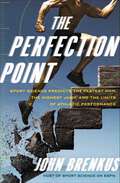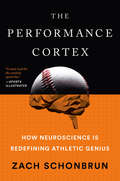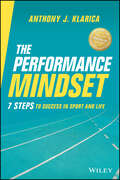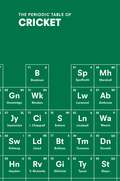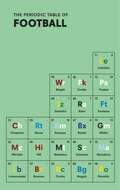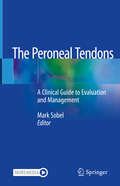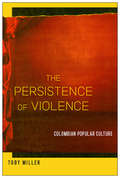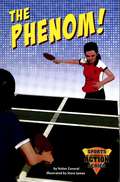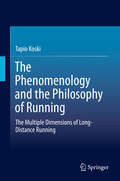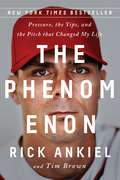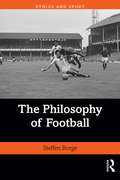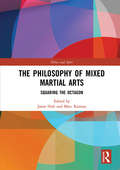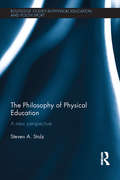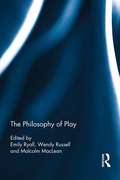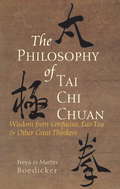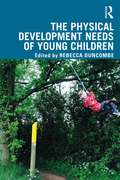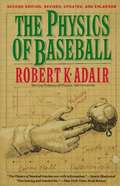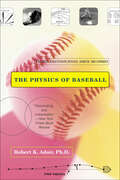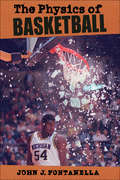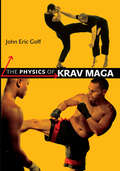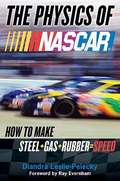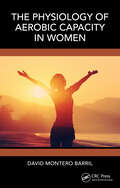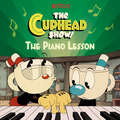- Table View
- List View
The Perfection Point: Sport Science Predicts the Fastest Man, the Highest Jump, and the Limits of Athletic Performance
by John BrenkusWhat's the fastest a human can run the 100-meter sprint? What's the longest a human can hold his breath? What are the limits of human performance?Welcome to The Perfection Point.Until 1954, common wisdom and scientific knowledge considered a sub-four-minute mile an impossible feat for a human. But then Roger Bannister broke that mark, followed quickly by a host of other athletes. Today the world record stands at 3 minutes, 43 seconds, yet even that number doesn't tell the full story of how fast humans can run a mile—records are a mark of how well people have done, not how well they can do. What's the actual limit? The answer lies in The Perfection Point.In this fascinating and thought-provoking book, John Brenkus, the host, co-creator, and executive producer of ESPN's Sport Science, ventures across the sports world to provide an in-depth look at the absolute limits of human performance. Beginning with the current world records for a variety of sports, Brenkus finds the “perfection point” for each, zeroing in on the speeds, heights, distances, and times that humans will get closer to but never exceed.Combining cutting-edge science with the fundamentals of each sport, Brenkus answers questions as old as competition itself, exploring the outer realm of what's possible in athletics. Using engrossing and accessible language, he applies statistics, physics, and physiology to uncover perfection points such as: the highest dunkthe longest home runthe fastest milethe longest golf drivethe heaviest bench pressIntriguing, detailed, and controversial, the answers that Brenkus provides are essential reading for every sports fan. For years, coaches, pundits, and experts have speculated about the extremes of human ability. The Perfection Point finally provides the answers.
The Performance Cortex: How Neuroscience Is Redefining Athletic Genius
by Zach Schonbrun“A must-read for the cerebral sports fan…like Moneyball except nerdier. Much nerdier.” --Sports IllustratedWhy couldn't Michael Jordan, master athlete that he was, crush a baseball? Why can't modern robotics come close to replicating the dexterity of a five-year-old? Why do good quarterbacks always seem to know where their receivers are?On a quest to discover what actually drives human movement and its spectacular potential, journalist, sports writer, and fan Zach Schonbrun interviewed experts on motor control around the world. The trail begins with the groundbreaking work of two neuroscientists in Major League Baseball who are upending the traditional ways scouts evaluate the speed with which great players read a pitch. Across all sports, new theories and revolutionary technology are revealing how the brain's motor control system works in extraordinary talented athletes like Stephen Curry, Tom Brady, Serena Williams, and Lionel Messi; as well as musical virtuosos, dancers, rock climbers, race-car drivers, and more.Whether it is timing a 95 mph fastball or reaching for a coffee mug, movement requires a complex suite of computations that many take for granted--until they read The Performance Cortex. Zach Schonbrun ushers in a new way of thinking about the athletic gifts we marvel over and seek to develop in our own lives. It's not about the million-dollar arm anymore. It's about the million-dollar brain.
The Performance Mindset: 7 Steps to Success in Sport and Life
by Anthony J. KlaricaLearn the lessons of elite athletes to reach your full potential From acclaimed psychologist Anthony Klarica, The Performance Mindset: 7 steps to success in sport and life reveals the lessons of high-performing athletes and shows how you can build strategies to apply for greater success in sport, business or in your personal life. High performers are made, not born. High performance occurs through putting a careful and deliberate focus on growing mindset, and science proves that high-performers intentionally build these mindset skills and habits to maximise their opportunities. Talent and hard work are simply not enough. Through candid, in-depth interviews and stories from a wide variety of Australian athletes, you’ll learn how to: harness and maintain your motivation become resilient stay focussed and present lead yourself and others protect your mental health and wellbeing.Natural talent doesn’t necessarily equal high performance. With The Performance Mindset: 7 steps to success in sport and life, you’ll discover how to unleash your inner-champion and realise your full and unbridled potential, whether in sport, in business, or in life.
The Periodic Table of CRICKET
by John SternWelcome to The Periodic Table of Cricket. Here you'll find the essential elements - batsmen and bowlers past and present - that have left a lasting legacy on this great sport.As with chemical elements, these international personalities have been arranged based on their characteristics in and out of play. Instead of metals and non-metals, here we have patient and determined defensive players, from Jack Hobbs to Hanif Mohammad and Alastair Cook transitioning to fast-paced and attacking players including Shane Warne, Fred Trueman and 'white lightning' Allan Donald with a whole host of others in between.See how the best international players stack up against each other in this original guide to cricket.
The Periodic Table of FOOTBALL
by Nick HoltYou can never take what you love too seriously and The Periodic Table of Football celebrates this fact.Welcome to The Periodic Table of Football. Instead of hydrogen to helium, here you’ll find Pelé to Sepp Blatter – 108 elements from the football pantheon arranged by their properties and behaviour on and off the pitch.This expert guide spans over 150 years to offer an original perspective of the beautiful game.
The Peroneal Tendons: A Clinical Guide to Evaluation and Management
by Mark SobelThis unique book is a practical, “go to” source of comprehensive information on the care of peroneal tendon injuries, accurately illustrating this hot topic with many anatomical drawings of how the anatomy influences the diseases we see clinically. This presentation opens with a review of the normal anatomy, biomechanics and examination of the peroneal tendons, followed by a discussion of congenital variations and imaging strategies used in diagnosis and evaluation. Both conservative and surgical management techniques are then elucidated in injury-specific chapters, from peroneus brevis splits and stenosing tenosynovitis to painful os peroneum syndrome (POPS) and acute dislocation. Chapters on rehabilitation and comorbid pathologies round out the presentation. The diagnosis of peroneal tendon injury is much more common today than it was 20 years ago. Utilizing the latest evidence and presenting the most cutting-edge management techniques, The Peroneal Tendons will be useful for orthopedic and podiatric surgeons, sports medicine specialists, and students and residents in these areas.
The Persistence of Violence: Colombian Popular Culture
by Toby MillerColombia’s headline story, about the peace process with guerrilla and its attendant controversies, does not consider the fundamental contradiction of a nation that spans generosity and violence, warmth and hatred—products of its particular pattern of invasion, dispossession, and enslavement. The Persistence of Violence fills that gap in understanding. Colombia is a place that is two countries in one—the ideal and the real—summed up in the idiomatic expression, not unique to Colombia, but particularly popular there, "Hecha la ley, hecha la trampa" (When you pass a law, you create a loophole). Less cynically, and more poetically, the Nobel Laureate Gabriel García Márquez deemed Colombians capable of both the most noble acts and the most abject ones, in a world where it seems anyone might do anything, from the beautiful to the horrendous.The Persistence of Violence draws on those contradictions and paradoxes to look at how violence—and resistance to it—characterize Colombian popular culture, from football to soap opera to journalism to tourism to the environment.
The Phantom Homer (Mel Martin Baseball Stories)
by John R. CooperMel Martin, young right-hander with a quick-breaking curve, is the main figure in this action-packed series. While baseball is Mel's major interest, somehow mystery and danger seem to follow him and his friends in whatever they do. Mel and the Wright twins constantly find themselves in ticklish situations as Mel's detective work involves them in skirmishes with crooks and mysterious strangers.
The Phenom! (Fountas & Pinnell LLI Purple #Level P)
by Nolan ZavoralThe Phenom! by Nolan Zavoral, illustrated by Steve James
The Phenomenology and the Philosophy of Running
by Tapio KoskiThis book describes and analyzes the levels of experience that long-distance running produces. It looks at the kinds of experiences caused by long-distance running, the dimensions contained in these experiences, and their effects on the subjective life-world and well-being of an individual. Taking a philosophical approach, the analysis presented in this book is founded on Maurice Merleau-Ponty´s phenomenology of the body and Martin Heidegger´s fundamental ontology. Running is a versatile form of physical exercise which does not reveal all of its dimensions at once. These dimensions escape the eye and are not revealed to the runner conceptually, but rather as sensations and emotions. Instead of concentrating on conceptual analysis, this book explores the emotions and experiences and examines the meaning that running has in runners´ lives. Using the participative method, in which the author is both the research subject and the researcher, the book contributes to the philosophy of physical exercise.
The Phenomenon: Pressure, The Yips, And The Pitch That Changed My Life
by Rick AnkielRick Ankiel had the talent to be one of the best pitchers ever. Then, one day, he lost it.The Phenomenon is the story of how St. Louis Cardinals prodigy Rick Ankiel lost his once-in-a-generation ability to pitch--not due to an injury or a bolt of lightning, but a mysterious anxiety condition widely known as "the Yips." It came without warning, in the middle of a playoff game, with millions of people watching. And it has never gone away.Yet the true test of Ankiel's character came not on the mound, but in the long days and nights that followed as he searched for a way to get back in the game. For four and a half years, he fought the Yips with every arrow in his quiver: psychotherapy, medication, deep-breathing exercises, self-help books, and, eventually, vodka. And then, after reconsidering his whole life at the age of twenty-five, Ankiel made an amazing turnaround: returning to the Major Leagues as a hitter and playing seven successful seasons.This book is an incredible story about a universal experience--pressure--and what happened when a person on the brink had to make a choice about who he was going to be.
The Philosophy of Football (Ethics and Sport)
by Steffen BorgeHuman beings are the only creatures known to engage in sport. We are sporting animals, and our favourite pastime of football is the biggest sport spectacle on earth. The Philosophy of Football presents the first sustained, in-depth philosophical investigation of the phenomenon of football. In explaining the complex nature of football, the book draws on literature in sociology, history, psychology and beyond, offering real-life examples of footballing actions alongside illuminating thought experiments. The book is organized around four main themes considering the character, nature, analysis and aesthetics of football. It discusses football as an extra-ordinary, unnecessary, rule-based, competitive, skill-based physical activity, articulated as a social (as opposed to natural) kind that is fictional in character, and where fairness or fair play – contrary to much sport ethical discussion – is not centre stage. Football, it is argued, is a constructive- destructive contact sport and, in comparison to other sports, is lower scoring and more affected by chance. The latter presents to its spectators a more unpredictable game and a darker, more complex and denser drama to enjoy. The Philosophy of Football deepens our understanding of the familiar features of the game, offering novel interpretations on what football is, how and why we play it, and what the game offers its followers that makes us so eagerly await match day. This is essential reading for anybody with an interest in the world’s most popular game or in the philosophical or social study of sport.
The Philosophy of Mixed Martial Arts: Squaring the Octagon (Ethics and Sport)
by Jason HoltMixed martial arts (MMA)—unarmed fighting games permitting techniques derived from a variety of martial arts and combat sports— has exploded from the fringes of sport into a worldwide phenomenon, a sport as controversial as it is compelling. This is the first book to pay MMA the serious philosophical attention it deserves. With contributions from leading international scholars of the philosophy of sport and martial arts, the book explores topics such as whether MMA qualifies as a martial art, the differences between MMA and the traditional martial arts, the aesthetic dimensions of MMA, the limits of consent and choice in MMA and whether MMA can promote moral virtues. It also explores cutting-edge practical and ethical topics, including the role of gender in MMA, and the question of whether trans athletes should be allowed to compete in the women’s divisions. The contributors to this anthology take down, ground and pound, and submit many essential questions about this fascinating recent development in the culture of sport and spectacle. This is important reading for anybody with an interest in combat sports, martial arts, or the philosophy, sociology, culture or history of sport.
The Philosophy of Physical Education: A New Perspective (Routledge Studies in Physical Education and Youth Sport)
by Steven A. StolzThe discipline area of physical education has historically struggled for legitimacy, sometimes being seen as a non-serious pursuit in educational terms compared to other subjects within the school curriculum. This book represents the first attempt in nearly thirty years to offer a coherent philosophical defence and conceptualisation of physical education and sport as subjects of educational value, and to provide a philosophically sound justification for their inclusion in the curriculum. The book argues that rather than relegating the body to “un-thinking” learning, a person’s essential being is not confined to their rationality but involves an embodied dimension. It traces the changing conceptions of the body, in philosophy and theology, that have influenced our understanding of physical education and sport, and investigates the important role that embodiment and movement play in learning about, through and in physical education. Physical education is defended as a vital and necessary part of education because the whole person goes to school, not just the mind, but the thinking, feeling and acting facets of a person. It is argued that physical education has the potential to provide a multitude of experiences and opportunities for students to become aware of their embodiment, explore alternative modes of awareness and to develop insights into and new modes of being not available elsewhere in the curriculum, and to influence moral character through the support of a moral community that is committed to that practice. Representing a sophisticated and spirited defence of the educational significance and philosophical value of physical education and sport, this book will be fascinating reading for any advanced student or researcher with an interest in physical education, the philosophy of sport or the philosophy of education.
The Philosophy of Play
by Emily Ryall Wendy Russell Malcolm MacLeanPlay is a vital component of the social life and well-being of both children and adults. This book examines the concept of play and considers a variety of the related philosophical issues. It also includes meta-analyses from a range of philosophers and theorists, as well as an exploration of some key applied ethical considerations. The main objective of The Philosophy of Play is to provide a richer understanding of the concept and nature of play and its relation to human life and values, and to build disciplinary and paradigmatic bridges between scholars of philosophy and scholars of play. Including specific chapters dedicated to children and play, and exploring the work of key thinkers such as Plato, Sartre, Wittgenstein, Gadamer, Deleuze and Nietzsche, this book is invaluable reading for any advanced student, researcher or practitioner with an interest in education, playwork, leisure studies, applied ethics or the philosophy of sport.
The Philosophy of Tai Chi Chuan
by Freya Boedicker Martin BoedickerThe essence of Tai Chi Chuan lies in the rich philosophy of ancient China. While most Tai Chi practitioners are aware of the value that studying Chinese philosophy can bring to their practice, it is often difficult to pick out those texts that are most relevant to Tai Chi and connected to its development. The Philosophy of Tai Chi Chuan presents, for the first time, a concise overview of the Chinese martial and spiritual philosophies that drive this ancient tradition.Authors Freya and Martin Boedicker, who teach Tai Chi throughout Europe and South Africa, present freshly translated excerpts from such popular and widely studied works as the Tao Te Ching, the I Ching, and The Art of War, as well as writings by philosophers and strategists such as Zhuangzi and Wuzi. Each chapter of this concise volume focuses on a single work or philosopher, and includes a short history of each one as well as a description of their relevance to Tai Chi. An extensive glossary of important Chinese terms rounds out the book. The Philosophy of Tai Chi Chuan offers readers a direct connection with the concepts that form the foundation of Tai Chi, inspiring a deeper understanding of the art and its applications.From the Hardcover edition.
The Physical Development Needs of Young Children
by Rebecca DuncombeWith growing concerns over declining levels of school readiness and physical activity, this book highlights the importance of quality early movement experiences and explores the connection between poor early Physical Development opportunities and later difficulties in the classroom. The book outlines the Physical Development needs of babies, toddlers and young children up to the age of eight, and suggests practical ways in which these can be provided for. It explores key concepts and terms, such as physical literacy, fundamental movement skills, sport, physical activity and Physical Education (PE), in relation to young children’s Physical Development needs and discusses age-appropriate provision. Advice is given to prevent movement difficulties from occurring, but it is acknowledged that not all children follow a typical Physical Development pathway, and, where this is the case, suggestions are provided to help put children "back on course." The Physical Development Needs of Young Children is important reading for all who work with or care for young children, including Early Years practitioners, primary school teachers, students who are studying to join these professions, and parents.
The Physics of Baseball
by Robert K. AdairScads of interesting facts about baseball as well as the physical laws of the game.
The Physics of Baseball: Third Edition, Revised, Updated, and Expanded
by Robert K. AdairA “fascinating and irresistible” blend of science and sports that reveals what a baseball (or bat, or player) in motion does—and why (The New York Times Book Review).How fast can a batted ball go? What effect do stitch patterns have on wind resistance? How far does a curveball break? Who reaches first base faster after a bunt, a right- or left-handed batter? The answers are often surprising—and always illuminating.This newly revised third edition considers recent developments in the science of sport such as the neurophysiology of batting, bat vibration, and the character of the “sweet spot.” Faster pitchers, longer hitters, and enclosed stadiums also get a good, hard scientific look to determine their effects on the game.Filled with anecdotes about famous players and incidents, The Physics of Baseball provides fans with fascinating insights into America’s favorite pastime.“Delivers scads of interesting facts.” —The Wall Street Journal
The Physics of Basketball
by John J. FontanellaDrain three pointers, slam dunk easily, and sink that buzzer beater from half court with the help of simple science. Your coach, physicist John J. Fontanella, shows how you can improve your game if you take advice from Isaac Newton. As you read, relive some of the great moments in the game—this time with a scientist and diehard basketball fan as your color analyst. Find out why you ought to put spin on the ball. Get tips on how to improve your free throw and increase your percentage from the charity stripe. You’ll even learn how to shatter the backboard, if that’s something you’ve always dreamed of doing. With photographs and simple high school formulas, physics professor Fontanella—who played in college against Pittsburgh and Syracuse—reveals the key pieces of physics that underscore basketball. He covers almost every aspect of the game, weaving in stories from games he’s played and games he’s seen, and tales from basketball history and folklore. Physics comes alive as you see how Kobe Bryant, Wilt "the Stilt" Chamberlain, Michael Jordan, Becky Hammon, and J. J. Reddick do naturally the things that Isaac Newton says they should.
The Physics of Krav Maga
by John Eric GoffThe art and science of real-world fighting. Explore the physics behind the physical!Krav Maga ("contact combat" in Hebrew) is a hard-hitting and efficient form of self-defense that was popularized by Israeli soldiers. Stressing practical, real-world fighting and a philosophy of self-defense, its popularity has grown worldwide over the past few decades. In The Physics of Krav Maga, John Eric Goff, a physicist, best-selling author, and martial arts practitioner, explains the science behind dozens of Krav Maga moves, from headlocks to hammer fists. Focusing on Warrior Krav Maga, a fighting style that combines the key elements of Krav Maga with kickboxing, wrestling, karate, and other fighting specialties, this equation-free, conceptual introduction is aimed at martial arts practitioners interested in refining their fighting technique and all fans of the fascinating moment when sports meet science.With step-by-step descriptions and detailed photos of each critical motion, Goff takes a scientific look at everything from punch speed to power output and reaction time. Armed with this book, readers will understand the physics behind each move. They will also learn how to• enhance their level of physical fitness• disrupt an opponent's balance—while keeping theirs• make use of leverage to defeat a larger, stronger attacker• become faster and more powerful• inflict pain up close• use weapons—and "weapons of opportunity"• and much more!Anyone interested in martial arts, in how physics applies to sports and combat, and in how a physicist wins a fight will love The Physics of Krav Maga.
The Physics of Nascar®
by Diandra Leslie-PeleckyA physicist explores the science of speed racing With 75 million fans, NASCAR is the #1 spectator sport in America. Now, in The Physics of NASCAR, a scientist explains the intricate and complex way the sport works, in terms that anyone who drives a car?or maybe occasionally looks under the hood?can easily comprehend. Based on her extensive access to NASCAR race shops, drivers, crew chiefs, engine builders, and pit crews during races, Diandra Leslie-Pelecky traces the life cycle of a race car from its creation at top race shops to competing in the door-todoor action of the NASCAR Sprint Cup Series. .
The Physiology of Aerobic Capacity in Women
by David Montero BarrilThis book questions the limitation of exercise capacity in women by discussing female physiology from the perspectives of respiratory, circulatory, skeletal, body composition, and training adaptations. Written in a compelling manner, the book covers not only gender differences in exercise physiology but also touches upon such questions as doping and novel mechanisms in exercise theory and practice. Based on first-hand research experience, this book offers new and realistic perspectives, including positive and negative aspects of women’s capacity to perform exercise, which should interest the readers of kinesiology, integrative physiology, clinical science, general science and sociology of sports topics.Key Features: Research-based findings on the cutting-edge topic of women's aerobic capacity Written in an accessible manner and packed with science-based insights Presents an overarching view of various medical disciplines that are essential in evaluating women's aerobic capacity
The Piano Lesson (Pictureback(R))
by Billy WrecksIt's music and laughs galore as Cuphead and Mugman tickle the ivories in this full-color retelling of the "Piano Lesson" from Netflix's hit animated series The Cuphead Show!The Cuphead Show! follows the adventures of two lovable brothers—Cuphead and Mugman—through their unique misadventures! But no matter what the trouble is, they&’ve always got one another&’s backs. But what happens when Mugman's dream of becoming a great pianist is dashed by an unexpected musical genius? Fans of the Netflix animated series or the video game that inspired it, will love this retelling with full-color images straight from the laugh out loud series!
